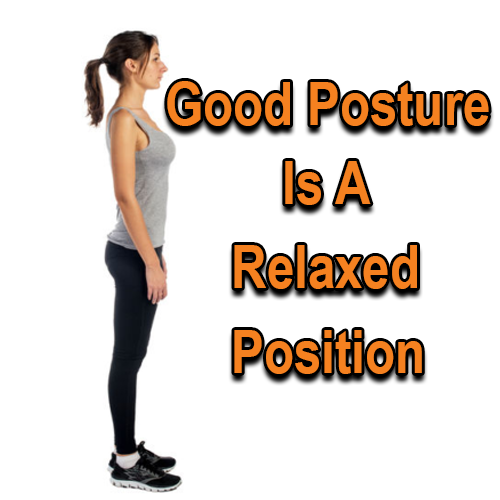Good Posture is a Relaxed Position

Good Posture is a Relaxed Position and you do it with ease.
Good posture requires no effort
Whether you are standing, walking, working or running, a gravity-neutral posture will help keep
you from fatigue and will help avoid injuries.
Good posture is when the weight of the body, including the head, is aligned so the weight of the body is born by the bones, and is held in balance by the gyroscope within your head. This balancing act is maintained by the tiny myofascial muscle strands within the big muscles. You are totally unaware of its happening.
Good posture requires no effort from your big muscles. This sounds easy—and it is.
The royal guards stand for hours without moving a muscle. That is because they are balanced in a gravity neutral position. I have stood at attention for 4 or 5 hours in the hot sun without moving a muscle and then, on order, marched off in a dignified formation and then marched for lengthy periods.
Here is how to have a good standing posture.
- Stand relaxed with your weight evenly on the heels and balls of your feet.
- Feet are spaced at a comfortable distance apart—just comfortable.
- Knees relaxed and slightly drawn back—not locked.
- Pelvis rotated slightly forward by tucking in your butt. This lets the spinal column have its natural curve and keeps the stomach from protruding.
- Shoulders are drawn back into a naturally relaxed position. There should be no tension. This helps keep the center of gravity directly above your feet. Your hands will fall naturally to be along the middle of your thighs.
- Bring your head back and pull your chin slightly in. This will balance head upon your neck so that the upper spine can maintain its natural curve—and will help center the body weight over the feet.
Make a good posture be part of your daily routine.
Good posture is user friendly to your body
Good posture at home, at work and play
A big problem in today’s world is that it is not always practical or even possible to maintain a body-friendly posture. Ergonomics—also known as comfort design—in today’s workplace is seriously lacking. (1)
Good posture is important when standing, bending over a workplace task, working as a cashier, working at a computer, and even walking, running. We should never forget ergonomics while we are going about our daily tasks—even when driving a car or truck.
For good posture and ergonomics to take place we need to pay attention to our physical position and the things we are doing to imbalance our body. This is easier said that than done, but is extremely rewarding.
Every time you move from the gravity-neutral position your body makes an adjustment. This helps explain why some jobs cause people to have protruding midsections. As the hands are raised or the head is looking under a car hood the body repositions itself to try to maintain a physical balance—gravity neutral.
We can sometimes help by placing one foot on a stool. At other times we can put one foot under the workbench. Brick layers have a terrible problem because they are always working some distance from their task and the spinal column can’t adjust very well.
Gravity Neutral Stance And Muscular Imbalance
When some muscles are used to counterbalance the body. Meanwhile, other muscles are permitted to get lazy. This can fatigue muscles that should not be working. This allows potential harm to the whole leg, arm, hip, neck back or any area that appears to not be part of the function.
Runners, weight lifters, cooks, cops, bank tellers—and even teachers who are constantly working at a blackboard, can suffer from this problem. In most cases no one cares but you, and you can do a lot.
Also, brief interludes of vigorous exercise may be the best choice of prevention and avoiding some of these problems. Yawning stretching or just closing your eyes and taking a deep breath can help your body relax. Tension also rears its ugly head—this gets worse with deferred pain problems. That is a subject for another day.
Some added thought:
The Marine Corps attention stance is relaxed and requires no effort. You can remain in this position for many hours with no effort.
- First, put your heels are together. Set the front ends spaced at 45° from the heels (see diagram.). Spacing lends stability to the feet and the body.
- Next, draw knees slightly back but not locked back. Keep them relaxed.
- Also, the hips are even across, relaxed, slightly back slightly and are even across.
- Now, rock the pelvis slightly rocked forward in a relaxed position. This keeps the natural curve in the lower spine that counteracts the reverse curve in the upper spine (See the diagram.)
- Relax the shoulders and hold them back and down into a natural position. This will keep the body balanced evenly on the front and back of the feet.
- Finally, hold your head back and tuck in your chin. So the head stays properly balanced on the neck.
In the real working world we can’t keep our feet in the attention stance—and we shouldn’t.
Resources:
1Ergonomics – Definition and More from the Free Merriam …
Full Definition of ERGONOMICS 1 : an applied science concerned with designing and arranging things people use so that the people and things interact most efficiently and safely —called also biotechnology, human engineering, human factors. 2 : the design characteristics of an object resulting especially from the application of the science of ergonomics.
| Tags | Category | Author |
|---|---|---|
| Tags: healthy living | jerry |